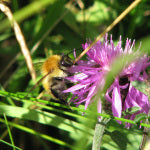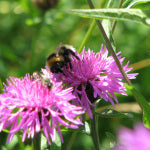Our Meadow in July
Share

 Our meadow is lovely at the moment; although the most obvious flowers are Greater Knapweed, Yarrow and Meadow Vetchling, the Self-heal and Lady's Bedstraw are also out. The meadow is alive with insects; it is buzzing and clicking, chirping and rustling. Fantastic. I thought I'd stand in a clump of flowering Knapweed (Centaurea scabiosa) for ten minutes in the morning and in the afternoon and see what came along. I'm no entomologist, so please excuse the identification, but how gratifying to see so many friendly pollinators. Nothing out of the ordinary, but a good crowd.There were, of course, many more, either too small or too fast for this useless photographer,
Our meadow is lovely at the moment; although the most obvious flowers are Greater Knapweed, Yarrow and Meadow Vetchling, the Self-heal and Lady's Bedstraw are also out. The meadow is alive with insects; it is buzzing and clicking, chirping and rustling. Fantastic. I thought I'd stand in a clump of flowering Knapweed (Centaurea scabiosa) for ten minutes in the morning and in the afternoon and see what came along. I'm no entomologist, so please excuse the identification, but how gratifying to see so many friendly pollinators. Nothing out of the ordinary, but a good crowd.There were, of course, many more, either too small or too fast for this useless photographer,  but at least this gives an idea of what you might help with a small meadow area...
Greater Knapweed is one of the best nectar plants, and it seems to attract all sorts of pollinators. Most obvious were the butterflies (and day flying moths). We've once again been swamped with Meadow Browns this year, but in my half an hour I also saw a Six Spot Burnet moth and a Small Tortoisehell. I'm sure we'll have Gatekeepers later on too. Although Greater Knapweed seems to be just the ticket for butterflies, it is more of a struggle for our honey bees with their much shorter tongues. Perhaps surprisingly they're not dissuaded,
but at least this gives an idea of what you might help with a small meadow area...
Greater Knapweed is one of the best nectar plants, and it seems to attract all sorts of pollinators. Most obvious were the butterflies (and day flying moths). We've once again been swamped with Meadow Browns this year, but in my half an hour I also saw a Six Spot Burnet moth and a Small Tortoisehell. I'm sure we'll have Gatekeepers later on too. Although Greater Knapweed seems to be just the ticket for butterflies, it is more of a struggle for our honey bees with their much shorter tongues. Perhaps surprisingly they're not dissuaded, 
 and in the afternoon sun were the most numerous insect about, with two or three simultaneously working the same patch. They were very specific in their taste, as were the Hoverflies; not for them Meadow Vetchling or Lady's Bedstraw. The solitary bees I saw were the same. Much quicker and more agile than bumblebees, there must have been at least 6 different species at work, although I only managed to photograph three. I'm still hopeless with my identification;
and in the afternoon sun were the most numerous insect about, with two or three simultaneously working the same patch. They were very specific in their taste, as were the Hoverflies; not for them Meadow Vetchling or Lady's Bedstraw. The solitary bees I saw were the same. Much quicker and more agile than bumblebees, there must have been at least 6 different species at work, although I only managed to photograph three. I'm still hopeless with my identification;
 I think there were Mason Bees of various types and Leaf-cutter bees too. Since we made our solitary bee box I have become more aware of these chaps and, consequently, see many more of them about, but still struggle to work out who is who. There are, after all, over 250 species to get to grips with and they all move fast. More work required. I am marginally more at home with bumblebees.
I think there were Mason Bees of various types and Leaf-cutter bees too. Since we made our solitary bee box I have become more aware of these chaps and, consequently, see many more of them about, but still struggle to work out who is who. There are, after all, over 250 species to get to grips with and they all move fast. More work required. I am marginally more at home with bumblebees.  Our garden and meadow areas have become Bumblebee Central, thanks to judicious planting and management. Although we have plenty of Common Carder Bees (below top left), I'm still disappointed not to have seen the Shrill Carder Bee, but I live in hope! I think I have also seen Brown-banded carder bees (Bombus humilis) about, but I couldn't be certain. The other unmistakable bumblebee around at this time of year is the Red Tailed Bumblebee, B. lapidarius. There's a nest under the orchard wall around 50 metres away, and it wasn't surprising to see a few workers of this very smart
Our garden and meadow areas have become Bumblebee Central, thanks to judicious planting and management. Although we have plenty of Common Carder Bees (below top left), I'm still disappointed not to have seen the Shrill Carder Bee, but I live in hope! I think I have also seen Brown-banded carder bees (Bombus humilis) about, but I couldn't be certain. The other unmistakable bumblebee around at this time of year is the Red Tailed Bumblebee, B. lapidarius. There's a nest under the orchard wall around 50 metres away, and it wasn't surprising to see a few workers of this very smart 
 and relatively short tongued species around the nectar rich area where I was snapping. My identification skills start to go awry at this point, however. Apparently the key difference between B. hortorum, the Garden Bumblebee, and B. lucorum, the White-tailed bumblebee, is the yellow band at the bottom of the thorax. Tricky. I hope I've got this right. I think this is a White-tailed Bumblebee - i.e. without yellow band on thorax.
and relatively short tongued species around the nectar rich area where I was snapping. My identification skills start to go awry at this point, however. Apparently the key difference between B. hortorum, the Garden Bumblebee, and B. lucorum, the White-tailed bumblebee, is the yellow band at the bottom of the thorax. Tricky. I hope I've got this right. I think this is a White-tailed Bumblebee - i.e. without yellow band on thorax.  Common but endearing. This next lady, then, could well be B.hortorum, or a Garden Bumblebee worker. She is rather moth-eaten, but she does have a yellow band at the bottom of her thorax and, apparently, a very long tongue. If I'm lucky I can sex bumblebees, which you can do by looking at the antenna; long, round antenna mean a male. I might have some idea on bumblebee identification, but I know next to nothing about different hoverflies. I think I can only confidently name one of these. Like solitary bees I am astonished to find the vast number of native species - around 270 -
Common but endearing. This next lady, then, could well be B.hortorum, or a Garden Bumblebee worker. She is rather moth-eaten, but she does have a yellow band at the bottom of her thorax and, apparently, a very long tongue. If I'm lucky I can sex bumblebees, which you can do by looking at the antenna; long, round antenna mean a male. I might have some idea on bumblebee identification, but I know next to nothing about different hoverflies. I think I can only confidently name one of these. Like solitary bees I am astonished to find the vast number of native species - around 270 - 
 and they are strong enough flyers that, like butterflies, we also entertain migrants. I've always been told their larvae have an insatiable appetite for greenfly, but it turns out that only about a third of them eat aphids. They're interesting and attractive insects, though, and - surprise surprise - many are in decline as a result of habitat loss. I thought I'd add some to my gallery, as they frequented the Knapweed too.
and they are strong enough flyers that, like butterflies, we also entertain migrants. I've always been told their larvae have an insatiable appetite for greenfly, but it turns out that only about a third of them eat aphids. They're interesting and attractive insects, though, and - surprise surprise - many are in decline as a result of habitat loss. I thought I'd add some to my gallery, as they frequented the Knapweed too. 
 The meadow will start to look tired in a little while, and once some of the Knapweed goes to seed I'll cut it. I don't need the hay, so it doesn't matter if it's all stalky. The sheep are already running through some sections of it where there's nothing left to flower to save me the effort of cutting it. In the meantime I'm looking forward to more coffee breaks out there in the sun, and enjoying it as much as the birds seem to be.
The meadow will start to look tired in a little while, and once some of the Knapweed goes to seed I'll cut it. I don't need the hay, so it doesn't matter if it's all stalky. The sheep are already running through some sections of it where there's nothing left to flower to save me the effort of cutting it. In the meantime I'm looking forward to more coffee breaks out there in the sun, and enjoying it as much as the birds seem to be.  I haven't even begun to describe the Flycatchers, finches, martins and swallows... I'm just amazed by how much there is going on in such a small area, and equally amazed at how easy it has been to establish such a rich habitat. Immensely satisfying - go on, give it a go!
I haven't even begun to describe the Flycatchers, finches, martins and swallows... I'm just amazed by how much there is going on in such a small area, and equally amazed at how easy it has been to establish such a rich habitat. Immensely satisfying - go on, give it a go!

